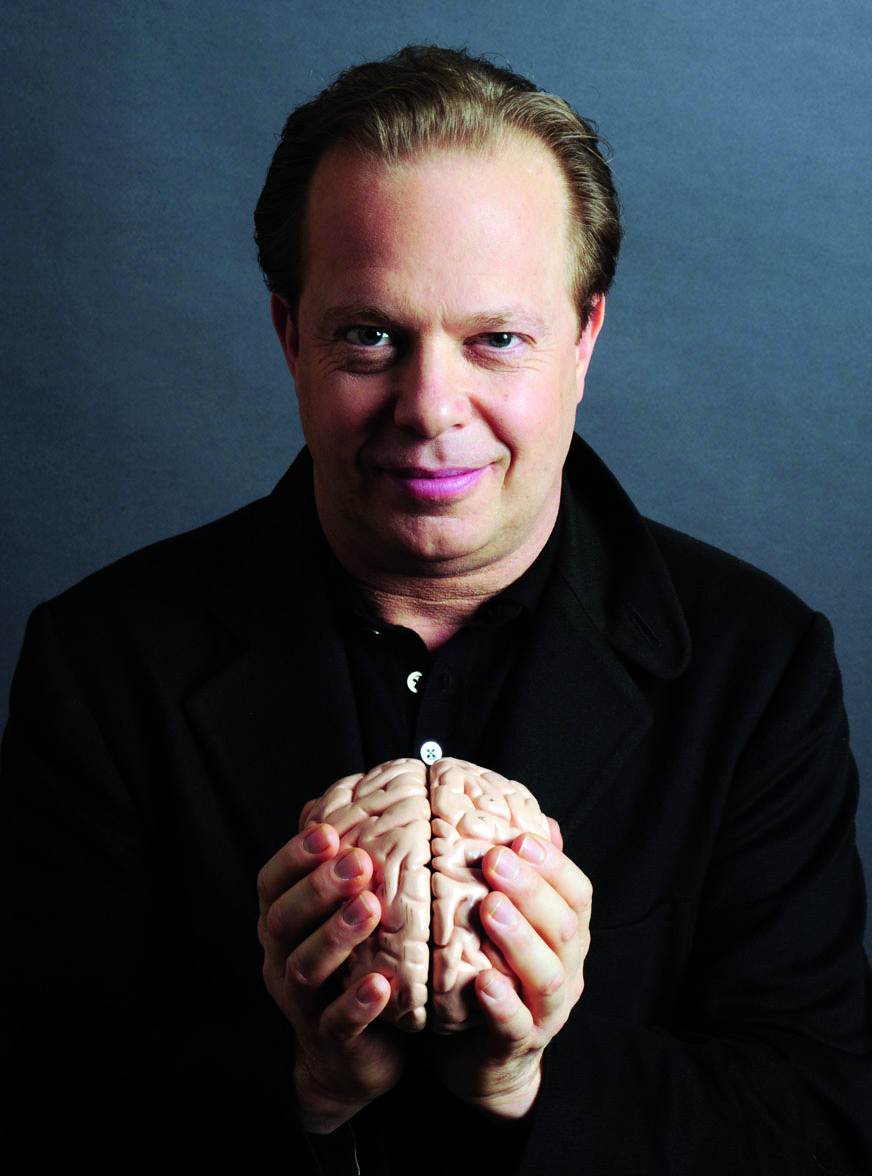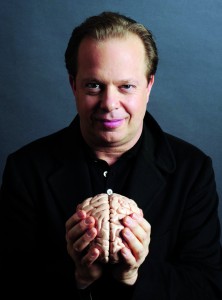Reshape Your Brain… and Reality
By Kevin Curtis
Simply picking up this magazine, feeling the texture of its pages and reading these words, has physically changed your brain. In fact, science tells us that every experience we have rewires our brain’s neural pathways, changing its structure and function, as we adapt to our environment. This ability of our brain to change and evolve is called neuroplasticity.
In our search for a deeper understanding of neuroplasticity and how we can consciously shape our brain and change our inner and outer realities, we invited Dr Joe Dispenza, famously known for his roll in the docudrama, What the Bleep Do We Know, and Professor Ian Robertson, of Trinity College Dublin, to offer their piercing insights into this reality-bending subject.
While speaking with Joe and Ian, I learned some simple, yet powerful methods that have allowed me to consciously change my brain and transform my personal reality. During our conversations, what struck me most was the simplicity of the methods used and how profound and far-reaching they are. Let me share with you some of this knowledge, so you can experience as much positive change in your life as I have in mine.
Reality
Here’s what Joe Dispenza says about reality. “Your personality creates your personal reality. So if you want to create a new personal reality, then on a fundamental level, you would have to change some way you think, act or behave, otherwise you’re trying to create a new personal reality as the same personality.” This is why so many of us get stuck before getting off the starting blocks of our personal transformation journey.
The process of conscious change recommended by Joe is achieved in two stages. First, he tells us we need to become aware of what we want to change, and secondly, to think about who we wish to become. This, he tells us, can be achieved through contemplation and meditation.
Meditation
Joe teaches mindfulness meditation as a powerful technique for transforming our brain, mind, and personal reality. Using meditation helps to make our inner world more real than our outer world, which allows the brain and body to change in accordance with our thoughts.
Here’s what Ian Robertson has to say about training our attention, which is the most essential element of this meditative practice. “At first, your attention will drift after a minute or two, but like a muscle, it can be trained and strengthened. So you start by holding your attention for a minute, slowly increasing the duration each time you practice. By setting goals, eventually you will be able to maintain your attention for 20 minutes, half an hour or longer.”
As we apply our attention, reminding ourselves of whom we no longer wish to be (as in the first stage of the process), Joe explains, the frontal lobes quieten down the circuits in your brain connected to the old you. Because neurons that stop firing together stop wiring together, your old personality is gradually unlearned.
As we imagine who we want to become, in the second part of the process, new circuits light up and begin forming the new you. In this case, neurons that fire together wire together, so a new personality and reality begin to emerge.
The mental gym
A powerful technique used for changing our behaviours and enhancing our real life skills is something Ian Robertson calls the mental gym. This is a form of active meditation, where we are imagining ourselves carrying out actions or specific behaviours. In this way, it is a perfect method we can use for the second stage in our transformational process.
To teach us about this amazing tool of the mind, Ian explains what it is and how we can use it. “If we realistically imagine doing something, such as having a difficult conversation with our partner or boss, the more practised and rehearsed we are, the more automatic our behaviour will become and the less vulnerable we will be to the real-life nerves at the time of the actual conversation.” In other words, the more you practise something, the more immune you will be to the effects of performance panic and anxiety.
Ian says, “the amazing thing about this is that you don’t have to practise in reality, although it helps; you can learn to do very detailed rehearsals in your mind’s eye, not just visualising, but hearing the sounds and feeling the sensations in your body, engaging all of your senses in the experience. The more you mentally rehearse and the more detailed you can be, the better skilled you will become. Being thrown off by performance anxiety will also be less likely. This is because when you imagine an event or performance, you use most of the brain circuits you would use while performing in reality.”
Ian also points out, “an important element of this method is not to run through the imagined event quickly, but to see yourself doing it in the same time frame as you would in the real world.”
We can use the mental gym as a way of changing our emotional reactions. Doing this, Joe tells us, “when the body is signalled to emotionally believe an event has already happened ahead of the actual experience, we are biologically changed, and that’s when the event finds us. This is the law of attraction.”
Mind-Body relationship
To better understand the process of change, Joe describes the mind-body relationship. “Every time you have a thought, you make a chemical. Specific emotions turn on certain circuits in your brain that fire in various combinations to produce a level of mind. That level of mind stimulates another part of your brain to release a chemical so you can begin to feel exactly the way you think. The moment you begin to feel the way you think, because the brain is in constant communication with the body, you begin to think the way you feel, and the cycle continues. This cycle, for some people, can go on for 20 years. The repetition of the cycle conditions the body to memorise an emotional reaction better than the conscious mind, and whenever the body knows better than the mind, it’s called a habit.
“The repetition of this cycle creates a state of being. A state of being is when our mind and body are working together and our thoughts and emotions are aligned to a concept. So a person says I am insecure or sad… etc.
“Most people, because the body doesn’t know the difference between stimulation from the external environment and fabricated emotions, live in the past, basing their reactions on past experiences.”
Breaking your emotional conditioning
One of the most interesting facts I learned while speaking with Joe was that the hormones we produce from an emotional reaction only last in the body for one to three minutes, unless we keep them going by our own volition. In which case, they can last for many years, as in the previous example.
We can benefit ourselves and escape this trap by learning how to shorten our emotional reactions to things. Joe tells us, “If you don’t know how to control your emotional reactions and there’s a refractory period, and you let that emotional reaction linger for hours or days, it turns into a mood.
“So you say to someone, ‘what’s wrong with you?’ The person says, ‘I’m in a mood.’ Then you say, ‘why are you in a mood?’ They say, ‘well, this thing happened to me five days ago and I memorised my initial reaction.’ If you keep that refractory period going for weeks and months, you’ve developed a temperament. If you keep that same refractory period going on for years, it’s called a personality trait,” says Joe.
“When we begin to develop personality traits based on our emotions, we’re living in the past and that’s where we get stuck. Teaching ourselves and our children to shorten the refractory period frees us to move through life without obstruction.”
The key to change
Joe explains the key to lasting change. “If you fully allow yourself to participate in the two-step process described, to the exclusion of everything else, your frontal lobe begins to quieten down all the circuits in the rest of the brain, and your present thought becomes your experience. The moment this happens, the experience produces an emotion and you begin to feel like that new ideal of yourself. As you begin to feel differently, your body becomes conditioned to a new mind.” This is where the magic happens: where our thoughts become reality.
Upgrading your brain
A few other things we can do to enhance our brain function include keeping hydrated, eating a brain-friendly diet (including foods rich in omega-3 oils such as flax seeds, oily fish, walnuts, and olives) getting daily exercise, and trying to learn something new. All of this helps sharpen the mind and grows new brain cells in a process called neurogenesis. Lastly, the brain needs a constant supply of oxygen to function, so proper breathing habits, which can be enhanced by hyperbaric oxygen treatment, are essential.
The bottom line
Your brain is physically changing and rewiring itself every time you have an experience. We can, if we choose to, guide this biological process in a positive direction by making small changes to our lifestyle and how we use our mind. “Decide who you want to be. If your personality creates your personal reality, and you are clear about who you want to be, you will move into a new state of being; a new state of being means a new personality, and a new personality creates a new reality,” says Joe.
How liberating and comforting it is, knowing we can give conscious direction to this process. So now that you have this knowledge, will you choose to apply it and become the sculptor of your own mind and reality?
For more information on this fascinating subject, I suggest reading the books Evolve your Brain by Joe Dispenza, and Mind Sculpture by Ian Robertson.
Dr Joe Dispenza’s latest book, Breaking the Habit of Being Yourself: How to Loose Your Mind and Create a New One, will be available in February 2012.
Professor Ian Robertson’s latest book, The Winner Effect: How Power Affects Your Brain, will be available in June 2012.
Kevin Curtis is founder of the Formless Art school; facilitating personal evolution through movement, posture, and meditative practices. He is currently writing a book called Bending Reality: A Warrior’s Guide.
www.formlessart.wordpress.com



